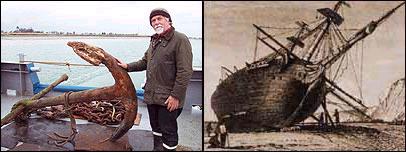Technology/ the evolution of ships * "Beagle 2" lost in space; Darwin's original "beagle" was probably found in the mud

The original "Beagle" (right) and the remains of an anchor from its last period as a coast guard ship
London. When the British space scientist Colin Pillinger had to choose a name for his space lander, he chose to call it "Beagle 2" - after the ship "Beagle", which was used by Charles Darwin on the journey following which he developed his theory of evolution. He certainly hoped that the lander, which was supposed to land on Mars in December 2003, would contribute to a scientific breakthrough at least as much as the contribution of the British Royal Navy ship at the time.
It seemed that the original "Beagle" and "Beagle 2" were indeed destined for a similar fate - although different from the one Pillinger intended: traces of the two disappeared. The ship disappeared in 1870 and landed at the end of December 2003, after being released from a spacecraft and started moving towards Mars. But now it is possible that the fate of one of the "Beagles" is about to change, and precisely the first one.
A team of maritime history researchers, who searched for Darwin's ship for four years, believe it is buried
In the marshes of Essex in the UK. The team is aided by innovative radar technology, which is able to distinguish objects even under layers of soil and swamp vegetation. Using this technology, wooden and metal remains were located, which probably made up the lower part of the ship.
In December 1831, the Beagle, with Charles Darwin on board, left Plymouth harbor for a voyage along the coast of South America. During the voyage, which lasted five years, Darwin studied a large number of plant species and fossils and traced the process of their development. He was particularly impressed by the diverse flora and fauna in Patagonia and the Galapagos Islands, where he found many species of birds, turtles, lizards and other animals. Upon his return to England, he used his findings and conclusions to compose his book "Origin of the Species".
After the journey, Beagle was transferred to the Coast Guard, which fights liquor and tobacco smugglers. Finally, in 1870, the ship - which was about 45 meters long and weighed about 235 tons (including ten cannons) - was sold to a scrap company and towed to an abandoned dock. Since then, mystery surrounds her footsteps.
The researchers, who were also helped by the space explorer Pillinger, gathered clues and evidence about her whereabouts from old maps and population censuses. These led them to a muddy site near Futon Island. After checking with remote-sensing instruments, they were convinced that they had found the ship buried in mud at a depth of about nine meters. The imaging systems identified beams and copper plates that belong, according to the scientists, to the hull of the ship.
The head of the search team, Dr Robert Prescott, who founded the Scottish Institute of Maritime Studies at the University of St Andrews, told the BBC that his team had identified the general outlines of the ship. "We can see the outline of the deck and identify pieces of wood and metal which, in our view, indicate with high probability a significant object buried there, most likely the lower part of the ship," he said, "It seems that this ship, which helped create a scientific revolution, met a sad end on the banks of a muddy river, where Time stood still for hundreds of years."
The CEO of the company that developed the radar, Gordon Stove, said: "We were involved in similar missions, but not every day you are involved in finding the ship of the father of evolution. She disappeared in an area with harsh weather and ground conditions, and in such an environment normal radar technologies are not effective enough. The remains on board the shipwreck resemble the materials from which the Beagle was made, and it seems that this is indeed Darwin's ship."
